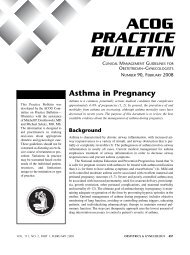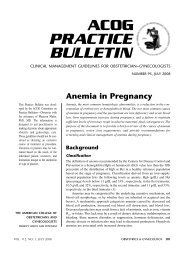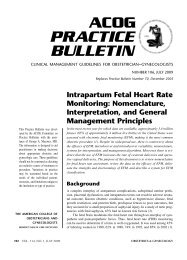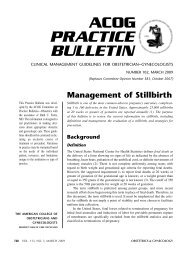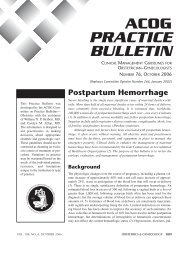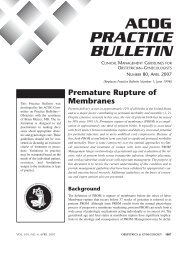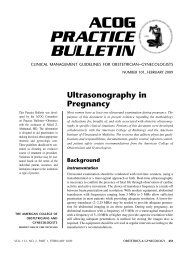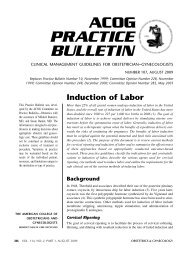ACOG Practice Bulletin No. 82: Management of Herpes in Pregnancy
ACOG Practice Bulletin No. 82: Management of Herpes in Pregnancy
ACOG Practice Bulletin No. 82: Management of Herpes in Pregnancy
Create successful ePaper yourself
Turn your PDF publications into a flip-book with our unique Google optimized e-Paper software.
and po<strong>in</strong>t-<strong>of</strong>-care serologic tests to detect the presence <strong>of</strong><br />
antibodies to either HSV-1 or HSV-2. With viral detection<br />
techniques, negative results do not rule out the presence<br />
<strong>of</strong> <strong>in</strong>fection. The diagnosis <strong>of</strong> HSV should be<br />
confirmed either serologically or with viral culture.<br />
Isolation <strong>of</strong> HSV <strong>in</strong> cell culture is the preferred virologic<br />
test for patients who seek medical treatment for<br />
genital ulcers or other mucocutaneous lesions and allows<br />
differentiation <strong>of</strong> the type <strong>of</strong> virus (HSV-1 versus HSV-<br />
2) (18). The sensitivity <strong>of</strong> this test is limited because <strong>of</strong><br />
several issues related to sampl<strong>in</strong>g and transportation <strong>of</strong><br />
the specimen (19). Primary lesions are more likely than<br />
recurrent lesions to yield positive cultures (80% versus<br />
40% <strong>of</strong> patients, respectively) (20, 21). Additionally, as<br />
the lesions heal, they are less likely to be culture positive<br />
(21). Thus, a positive genital culture provides conclusive<br />
evidence <strong>of</strong> genital HSV <strong>in</strong>fection; however, a negative<br />
result does not exclude the presence <strong>of</strong> <strong>in</strong>fection. When<br />
a genital specimen is collected for HSV culture, the vesicles<br />
should be unro<strong>of</strong>ed, if present, and vesicular fluid<br />
should be collected.<br />
Polymerase cha<strong>in</strong> reaction techniques <strong>in</strong>volve the<br />
amplification <strong>of</strong> particular sequences <strong>of</strong> DNA or RNA<br />
before detection and can thus detect evidence <strong>of</strong> viral<br />
DNA at low concentrations. Because <strong>of</strong> the <strong>in</strong>creased<br />
sensitivity <strong>of</strong> PCR, unro<strong>of</strong><strong>in</strong>g vesicles is unnecessary. In<br />
one very large study, PCR results were three to five times<br />
more likely to be positive than were cultures (19).<br />
Cultures were more likely to be positive at <strong>in</strong>creas<strong>in</strong>g<br />
concentrations <strong>of</strong> virus, as demonstrated by a l<strong>in</strong>ear relationship<br />
between the proportion <strong>of</strong> positive cultures and<br />
copy numbers <strong>of</strong> HSV DNA <strong>in</strong> samples. Polymerase<br />
cha<strong>in</strong> reaction techniques are commercially available<br />
and can differentiate between HSV-1 and HSV-2.<br />
Polymerase cha<strong>in</strong> reaction provides <strong>in</strong>creased sensitivity<br />
over culture (19, 20, 22) and may ultimately replace<br />
culture as the standard <strong>of</strong> care for diagnosis. Presently,<br />
however, there are no <strong>in</strong>terlaboratory standards that<br />
ensure that identical specimens processed <strong>in</strong> different<br />
laboratories will yield identical results. Additionally,<br />
the PCR tests are not U.S. Food and Drug Adm<strong>in</strong>istration<br />
(FDA) approved for cl<strong>in</strong>ical test<strong>in</strong>g <strong>of</strong> genital specimens<br />
(18).<br />
For patients who do not present with active lesions<br />
or whose lesions have negative culture or PCR test<br />
results, accurate type-specific serologic assays that accurately<br />
dist<strong>in</strong>guish between HSV-1 and HSV-2 antibodies<br />
are now commercially available. Currently, there are several<br />
FDA-approved type-specific tests, and others are<br />
under development (see box). The sensitivity <strong>of</strong> these<br />
assays varies from 93–100% and specificity from<br />
93–98% (23). The predictive value <strong>of</strong> a positive test<br />
result is <strong>in</strong>fluenced by the prevalence <strong>of</strong> the disease <strong>in</strong><br />
U.S. Food and Drug Adm<strong>in</strong>istration-<br />
Approved Type-Specific Tests<br />
Laboratory-based assays<br />
• HerpeSelect-1 and 2 ELISA IgG<br />
• HerpeSelect 1 and 2 Immunoblot IgG<br />
• Captia HSV-1 and 2 ELISA<br />
Rapid tests (formerly known as the POCkit test)<br />
• BiokitHSV-2 Rapid Test<br />
• Sure-Vue HSV-2<br />
the population tested. In a high-risk population, the positive<br />
predictive value for the ELISA test results was<br />
80–94% (24, 25). Repeat test<strong>in</strong>g, us<strong>in</strong>g a different typespecific<br />
assay, has been shown to <strong>in</strong>crease the positive<br />
predictive value <strong>of</strong> a s<strong>in</strong>gle test result, and this may be<br />
especially important <strong>in</strong> populations with low HSV prevalence<br />
(24).<br />
Because HSV-2 is an uncommon cause <strong>of</strong> oral<br />
<strong>in</strong>fection, detection <strong>of</strong> HSV-2 antibodies is virtually<br />
diagnostic <strong>of</strong> genital HSV <strong>in</strong>fection (26). Conversely,<br />
detection <strong>of</strong> HSV-1 antibodies alone may represent orolabial<br />
<strong>in</strong>fection or may be <strong>in</strong>dicative <strong>of</strong> genital <strong>in</strong>fection.<br />
Correlation with direct viral identification techniques<br />
and the patient’s symptoms is important.<br />
How can primary herpes simplex virus <strong>in</strong>fection<br />
be dist<strong>in</strong>guished from a nonprimary first<br />
episode dur<strong>in</strong>g pregnancy<br />
It is not possible to dist<strong>in</strong>guish primary from nonprimary<br />
herpes simplex virus <strong>in</strong>fection on the basis <strong>of</strong> cl<strong>in</strong>ical<br />
f<strong>in</strong>d<strong>in</strong>gs alone (27). Diagnosis is based on the<br />
comb<strong>in</strong>ation <strong>of</strong> positive viral detection and negative<br />
serologic test results or evidence <strong>of</strong> seroconversion.<br />
A primary outbreak <strong>in</strong> the first trimester <strong>of</strong> pregnancy<br />
has been associated with neonatal chorioret<strong>in</strong>itis,<br />
microcephaly, and sk<strong>in</strong> lesions <strong>in</strong> rare cases (28).<br />
Although HSV has been associated with an <strong>in</strong>creased<br />
risk for spontaneous abortion, recent studies do not support<br />
such a risk (29).<br />
How should a primary outbreak be managed<br />
<strong>in</strong> pregnancy<br />
At the time <strong>of</strong> the <strong>in</strong>itial outbreak, antiviral treatment<br />
may be adm<strong>in</strong>istered orally to pregnant women to reduce<br />
the duration and the severity <strong>of</strong> the symptoms as well as<br />
reduce the duration <strong>of</strong> viral shedd<strong>in</strong>g (Table 1) (30). In<br />
patients who have severe disease, oral treatment can be<br />
VOL. 109, NO. 6, JUNE 2007 <strong>ACOG</strong> <strong>Practice</strong> <strong>Bullet<strong>in</strong></strong> <strong>Management</strong> <strong>of</strong> <strong>Herpes</strong> <strong>in</strong> <strong>Pregnancy</strong> 1491



